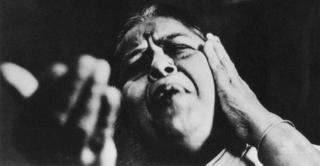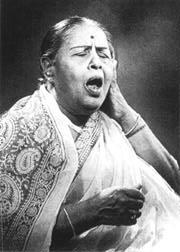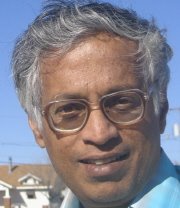Dr. K.Rohiniprasad


When a competent singer sings light classical music like thumri, it can sound as expansive and rich as a khayal. Siddheswari Devi (1903-1977) who popularised the Poorab style of the thumri endowed it with classical dignity while maintaining its lyricism and expressiveness. With a vast repertoire she became an institution by herself.
Thumris were originally sung with abhinaya but classical musicians replaced gestures with the emotional content of the song brought out by musical expression. The beauty of notes and their combinations, voice modulation and emotion-charged style of singing came to mark thumri renderings. These modern performers included Bhaiya Ganpatrao, Moizuddin, Shyamlal Khatri and others.
Born into a famous musical family in Varanasi, Siddheswari lost her parents very early in life. Her maternal grandmother Maina Devi was a reputed singer. Siddheswari was brought up by her maternal aunt, Rajeswari, herself a famed disciple of Maina Devi, Mithailal, and Moizuddin. Other famous singers from her family included Vidyadhari Devi, Kamaleswari Devi and others. Thus Siddheswari could imbibe a great deal of music, occasionally depending on the neighbours’ gramophone. She was captivated by popular singers like Janakibai, Gauharbai and others. The talent and enthusiasm of the young girl prompted Siyaji Maharaj to teach her. Having no children of his own, he was generous and affectionate, treating her like his own daughter. She practised all the basic ragas and several khayals, tappas and taranas with intense concentration and devotion. After the death of Siyaji Maharaj, she learnt from Rajab Ali Khan (Dewas), and Inayat Khan (Lahore) and later, from Bade Ramdasji (Varanasi).
Siddheswari made her unforgettable debut at a Calcutta at the age of 18 and soon received invitations to perform at Rampur, Jodhpur, Lahore, Mysore and other places. Music was her passion. She practised music all the time even as she was cooking, washing clothes, or doing any household chore. She sang in several royal durbars, music conferences and radio broadcasts. Veterans of the time such as Omkarnath Thakur, Dilipchandra Vedi, Faiyaz Khan and others had high praise for her. Once Faiyaz Khan heard her Bhairavi thumri in Bombay and was too moved to perform after her, saying “After Gauhar, the crown of the thumri rests on your head".
As her fame grew, Siddheswari joined the Bharatiya Kala Kendra in Delhi as a professor, where she was known as a sincere and conscientious teacher. She received the Presidential Award (1966), Padmasri (1967), D.Litt. from Ravindra Bharati University, Calcutta, and Desikottama from the Viswa Bharati University. She performed in Rome, Kabul, and Kathmandu. In spite of all this, she remained simple and unassuming. She admired contemporaries like Kesarbai Kerkar and M.S. Subbalakshmi. With age her voice became "temperamental and thick" but she could offset that with her emotional fervour and intensity of feeling. With simple charm, purity of notes and voice modulation, she brought out all the salient features of the Banaras style.
Siddheswari was warm-hearted, simple, and loveable, full of innocence, courage, humour, generosity, youthful zest for life and rare dignity. Her religious temperament had a great impact on her singing. She believed that music was the medium for pleasing and attaining god. Not proud of her success and always humble, her music attained mellowness and maturity. With twinkling eyes, the solitary diamond in her big nose ring flashing points of light, a warm smile on her paan-reddened lips, she was very popular among music-lovers. Her last performance was a couple of years before her death. With an unhappy childhood, she suffered from ill-health towards the end of her life too. Her tradition is carried on by her younger daughter Savita Devi and Girija Devi.




1 Comments:
A good one. I loved it. Can you please provide your email id?
Regards
S. Gopalakrishnan
New Delhi
Post a Comment
<< Home